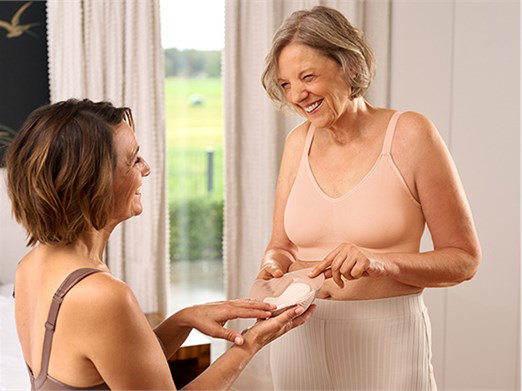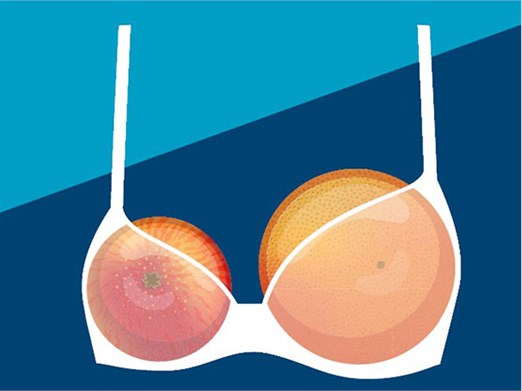Mirror Image - Self-confidence and Body Image
Choosing Surgical Options for Breast Cancer Treatment
By Lillie Shockney, RN., BS., MAS
Administrative Director, Johns Hopkins Breast Center
Breast cancer is a diagnosis all women fear. It is not surprising that hearing the words “you have breast cancer” is an overwhelming and commonly devastating experience. Most women experience the usual stages of a crisis—shock, denial, anger, understanding/acceptance—but how a woman reacts to the news is not universal. There is a difference among women regarding their emotional reaction to the actual surgery they will need to undergo in order to remove the source of this disease from her body.
Over my many years as an oncology nurse taking care of women with breast cancer, as well as my own personal diagnosis in 1992 and reoccurrence two years later; I have come to appreciate the importance of assessing a woman’s feelings about her breasts before surgery. As part of the medical assessment, when first talking with a patient about her diagnosis and surgical treatment plan health care providers need to learn about each woman’s relationship with her breasts.
Once a woman overcomes the immediate fear of losing her life, her next fear usually is losing part or all of her breast. It is important to understand how closely her perception of her body image and self-image is tied to her breasts. For many women, the fear of how others will perceive her altered body image is also difficult. There are still women alive and thriving today who underwent a Halsted (total) radical mastectomy, which was very debilitating surgery, yet the standard of care until 20 years ago. This is believed to contribute to images of fear of body mutilation for some women.
Physicians may be surprised at the way different women react to being told they need breast cancer surgery. One woman may say, “Take them both off. They don’t mean anything to me. They’ve never given me any pleasure.” But another patient may say, “Will I have a scar on my breast after the lumpectomy? Will it be visible in the mirror when I look at myself.” Two different responses yet both women may have the exact same stage of disease and treatment plan—lumpectomy with radiation.
I often ask patients, “Tell me what you recall about the first time you were fitted for a training bra? Good experience or bad? How important are your breasts when you are intimate with your partner? If you were asked to rank your physical attributes, where do your breasts fall in that ranking?” As a health care provider, the answers to these questions can lend valuable insight into how well a woman is likely to cope with the surgery she is about to undergo. An understanding of where a woman is before surgery may help in treating the woman after surgery. By anticipating reactions, you will be more successful at treating the whole person and not just the disease.
Society teaches us at a young age the importance of cleavage and mammary folds. I have a photograph of a 10-year old girl wearing a t-shirt that says boldly across the chest, “Watch this space”…and we do. I get emails from young girls ages 13 to 22 on the Johns Hopkins Breast Center’s Ask an Expert Website expressing concern that their breasts aren’t growing as quickly as their friends, or they don’t look symmetric or their nipples aren’t normal looking. Young people spend a fortune on bras designed to increase their bust size and depth of cleavage, even though it’s only an illusion. Girls where shoestring bikini tops and may actually expose 80% of their breast tissue but until we see the nipple and areola we don’t actually think we have seen a woman’s breasts.
A woman’s personal preference to do lumpectomy with radiation versus mastectomy versus mastectomy with reconstruction is often driven by her feelings about her breasts. If educated and assured that all three surgical options are equal from a survival perspective, her choice will usually be driven by emotions.
A woman who was a great candidate for lumpectomy with a small tumor under 1 cm insisted upon having bilateral mastectomies. Her surgeon could not persuade her to choose a less radical option. In talking with the patient in private about her choice she candidly told me she had been an incest victim as a child and felt that her breasts had been a curse to her since she was 12 years old. She wanted them gone because they harbored nightmares of her past. She suspected, despite being well educated and usually rational, that “they were cursed” and she longed to have them off of her. She underwent bilateral mastectomies and a lot of psychotherapy following her surgery, frankly unrelated to her diagnosis and treatment of breast cancer.
Another woman, also with very early stage breast cancer, was told she “only needed a lumpectomy and would hardly notice that any breast tissue was taken away.” She was devastated at the proposition of having a “scar on her breast that might look visible in a mirror”. In talking with her one on one I learned that she was born with spina bifida and had had many orthopedic and neurosurgery procedures throughout her life. The only part of her body she liked were her breasts, which now would also be surgically altered and scarred.
Often, we are also impacted by the perception of others, beyond that of our mate, for example our children. A patient having had locally advanced breast cancer underwent mastectomy without reconstruction, chemo and radiation. She had done well physically and psychologically with her treatment. Her focus was surviving to raise her 3 children all under the age of 5. Three years later she called me upset. Her 5 year old daughter had seen her as she stepped out of the shower, pointed to her mastectomy scar, crying, and said, “Mommy, am I going to look like that one day?” The woman said to me, “I want reconstruction. Please help me. I need to show my daughter that you can look normal and have two breasts even after aggressive breast cancer treatment.” A few weeks later, she underwent DIEP flap reconstruction and feels better for having done so.
Facing my own diagnosis of breast cancer, I was no different from most patients — I quickly discovered having 44Ds on my chest, that part of my self-image was tied up on my chest. I faced mastectomy without the option for reconstruction twice—at age 38 and 40. If it weren’t for my husband teaching me that I needed to look at the surgery in a different way—as transformation surgery I don’t know how I would have managed things psychologically alone. He said the surgery would transform me from a victim into a breast cancer survivor. After my surgery, I focused on being optimistic and was thankful that my life was being spared. I also learned that a woman’s femininity is as much in her mind as it is in her silhouette. It is truly not based on breast ducts, lobules and breast fat cells. Having the privilege of being reconstructed 10 years later however reaffirmed for me that my psychological well being though healthy, could be made better by restoring that which I lost to cancer a decade before.
The message here—the relationship a woman has with her breasts influences her decision making about her breast cancer treatment, her emotional well being during and after treatment, and for that matter, perhaps even how much she fears getting this disease to begin with. Culturally, as a society, we need to take a different approach when teaching our children and grandchildren more about self-image. It should be tied to self-respect, the values we teach them and the feminine strength that womanhood should represent. And for women facing a diagnosis of breast cancer, inform your surgical oncologist and oncology nurse about your relationship with their breasts. Participate in the decision-making. Be sure the type of surgery you choose addresses with your psychological well being too. We each have the right to choose, but choice should also not be made in haste but after careful thought, education, and planning. A year after a woman completes her treatment I want to hear her say, “I’m happy with the treatment choices I made.”







